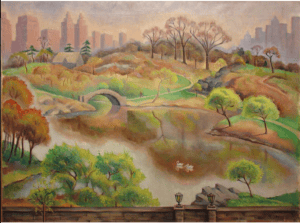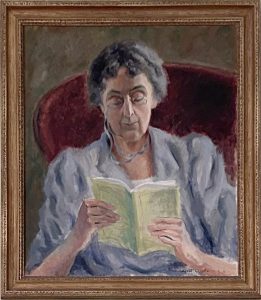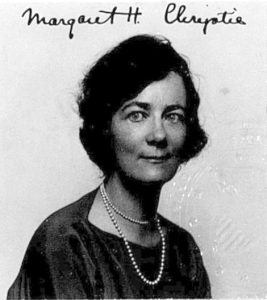Margaret Chrystie
By Anne Deally, Director of Education and Public Informaion
In preparation for our 2025 specialty tour, “From Needle to Brush: Women and Art,” I spent time researching the artwork connected with women that curator John Marks hung in the mansion this season in conjunction with the exhibit Without Asking Permission: The Art of Agnes Swan Hutchins and Margaret Hutchins. None of the female artists featured in the house have the recognition of a Berthe Morisot or a Mary Cassatt, but their work and their stories reveal a lot about the ways women expressed their creativity in the 19th century.
One artist who came as a surprise to me was Margaret Chrystie, who painted the portrait of Agnes Swan Hutchins that hangs in the sitting room to the north of Rose Hill’s main entrance. Chrystie’s name jumped out at me because it was the married name of one of Adelaide and Phineas Prouty’s daughters. Allie Prouty married Dr. Walter Chrystie in 1887 and moved to Philadelphia. They had two sons and a daughter, Margaret, born in 1893. Agnes Swan was just six years younger than Allie Prouty, and Margaret Hutchins and Margaret Chrystie were close in age. In Geneva’s small society, the Prouty and Swan families would have been acquainted. According to Warren Hunting Smith’s book Gentle Enthusiasts in Art, Margaret Chrystie was one of Margaret Hutchins’ many artist friends. She came to stay with her in Geneva, painted plein air with Hutchins and other Geneva artists, and introduced Hutchins to Philadelphia artists of the early 20th century, like Hobson Pittman. She painted the portrait of Agnes during one of these visits in 1938.
Since Margaret Chrystie did not live in Geneva, we have no information in our archive about her. The internet, however, does provide some additional details about her life and work. She seems to have had a typical upper-class youth in the Philadelphia area, primarily in Bryn Mawr. Her name comes up frequently in the 1910s and 1920s Philadelphia society pages, where she is referred to as a debutante. There were announcements of luncheons in her honor, trips out of town to stay with friends, dances, and work on charitable projects.
Like Margaret Hutchins, family interest and wealth enabled Chrystie to pursue art. Her grandfather, Phineas Prouty Jr., was an amateur artist, and according to Allie Prouty’s obituary, her mother was also an artist. Margaret Chrystie studied at the Philadelphia School of Occupational Therapy and the Pennsylvania Academy of Fine Arts (PAFA). At the Academy, she was instructed by Fern Isabel Coppedge, who was trained by William Merritt Chase. Coppedge was part of the Pennsylvania Impressionists, artists who worked around New Hope, Pennsylvania and were interested in quality of color and light and how they shifted over the course of the day. They often painted outdoors. Their influence can be seen in Chrystie’s work.
Chrystie worked as a lithographer and art teacher at the PAFA and the Wayne Art Center. Her paintings were frequently displayed at art shows throughout the Philadelphia area in the 1930s, 40s, and 50s. Unlike Margaret Hutchins, Chrystie did sell some of her works, including to the Woodmere Museum of Art and the PAFA. Based on her known works, Chrystie painted portraits, landscapes, and still lifes. She worked with blended masses of color more than line, like other early 20th-century post-Impressionists.

Margaret Chrystie’s painting of Central Park. From George Glazer Gallery website, September 19, 2025.
Like Margaret Hutchins, she lived with her parents until their deaths and never married or had children. Following her death, the Wayne Art Center established an award in her memory. Some of her works can be viewed online, as they have been auctioned in recent years. However, it does not appear that any of her work is currently on view in a museum, except for her portrait of Agnes at Rose Hill.
To learn more about women artists and the works at Rose Hill Mansion, join us for the specialty tour “From Needle to Brush: Women and Art” or for the lecture of the same name at Rose Hill on October 26 at 2 p.m.



Thank you Anne for the informative article about Margaret Chrystie and her painting of Agnes Swan and friendship with Margaret Hutchins